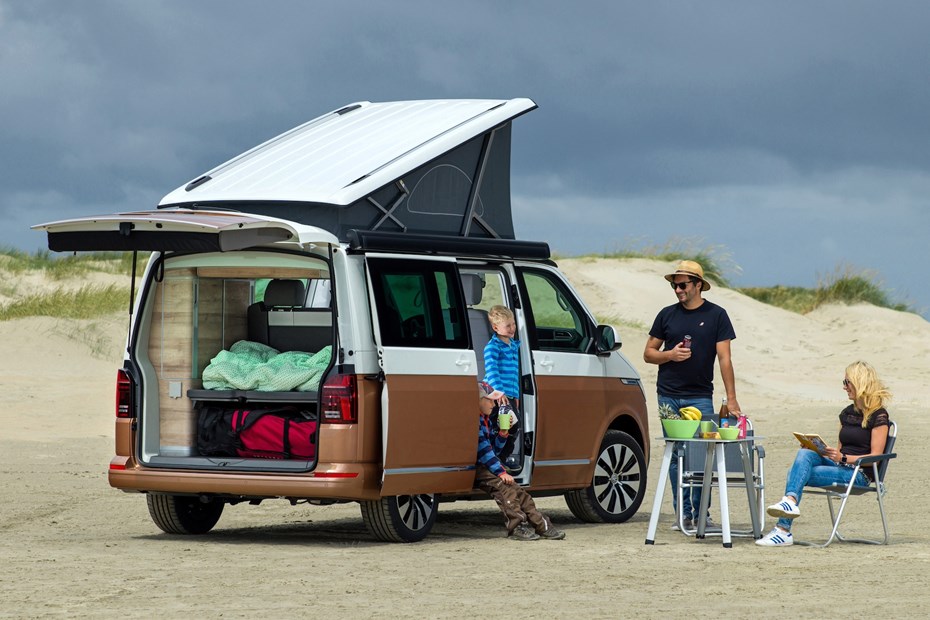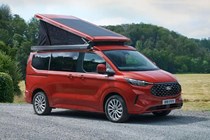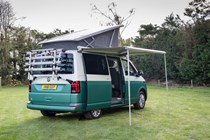The pandemic led to record sales of motorhomes and campervans as adventurous types rediscovered the beauty of the British countryside. If you’re interested in buying a camper, you could try and get your hands on a cheap yet cheerful Mazda Bongo, attempt a van conversion project, or opt for a more expensive, but probably more luxurious, factory-supported campervan.
Also known as a manufacturer-backed campervan, buying this type can relieve some of the stress associated with vans that aren’t factory-supported. In this guide, Parkers explains the pros and cons of these vehicles compared with third-party conversions.
What is a factory-supported campervan?
To give greater peace-of-mind, some campervans being released are officially backed by the vehicle manufacturers. Regardless of whether they’re built in-house or converted by a third party, all of these vehicles are sold, warranted and supported by the same company that manufactures the base vehicles.
Until the introduction of factory-supported vans, the only approach to getting a campervan was two-pronged; 1) find the shell, or base vehicle, then 2) deck it out with the living quarters.
Such an approach means there are three separate parties in the mix; the vehicle manufacturer, the custom fitters and the dealer.
Converters purchase vans from the vehicle manufacturer, and then fit them out with furniture, facilities and often add their own graphics and badging on top. Vans are then sold by dedicated motorhome dealers, some of them strongly affiliated with a couple of converters but often selling and supporting multiple campervan brands from all across Europe.
If everything goes smoothly, this arrangement works well. However, if problems arise with your van – do you visit the vehicle manufacturer, the converter, or the motorhome dealer that sold it to you?
That’s where manufacturer-backed campervans come in. We’ve listed all the examples currently on sale and looked at the pros and cons of each – click on the links below to jump directly to them.
We’ve also pitted two of these vehicles directly against each other – you can read our test of the Volkswagen California vs Ford Transit Custom Nugget here.
- Volkswagen California
- Volkswagen Grand California
- Volkswagen Caddy California
- Mercedes-Benz Marco Polo
- Ford Transit Custom Nugget
- Vauxhall Vivaro Elite Camper van
What are the pros and cons of a manufacturer-backed campervan?
Simplicity for the owner is the key factor in choosing a manufacturer-backed campervan. After all, when buying a car, you generally deal with one company that manufactures, sells and supports the vehicle through its lifetime. Buying a campervan and potentially having a base vehicle manufacturer, converter, motorhome dealer and separate finance company to worry about just makes life more confusing.
Prefer to convert your own van? Here’s our guide to DIY conversions
Manufacturer-supported campervans can be purchased at a main dealer for that brand and each part of the process is taken care of in the same place. You’ll see the VW California sat alongside Crafters and Amaroks at VW van centres, for example, or the Transit Custom Nugget rubbing shoulders with Fiestas at a normal Ford dealer.
Another advantage enables you to take out finance with the manufacturer, often more competitive interest rates than third-party alternatives, to pay for them. What’s more, the base vehicle and conversion warranties will be the same length and honoured by the same company.
Maintenance of both the van and conversion can be undertaken at the dealer, and repairs are more easily accomplished, too.
Another plus point tends to be quality. Giant multinational car manufacturers don’t want to attach their names to anything that isn’t high-quality, so even vehicles they don’t build themselves will be finished to exacting standards before they can be sold. This is especially true of Volkswagen, which builds all of its campervans itself in a dedicated factory. Not only are they finished to the same quality as its passenger cars, they’ll hold their resale value more favourably.
The high quality can be a double-edged sword though, in as much as, you pay for it. One of the disadvantages to factory-supported vans are the higher costs. These are at the higher end of the market, with highly specified base vehicles driving the prices higher. The lack of compromise on quality also means that where in a custom job you could splurge on something important to you, or highly visible, then cut your cloth differently in other areas.
These higher costs are coupled with a greater lack of choice too. This affects not only the base vehicle you can buy, but how heavily you can spec it. Most third-party converters allow you to be involved in the design process, specifying equipment or even altering the layout so your van is tailored completely to you. Those sold by car manufacturers, however, tend to have fewer customisable components; typically automotive-style options lists where you can select or deselect preferences and extras.
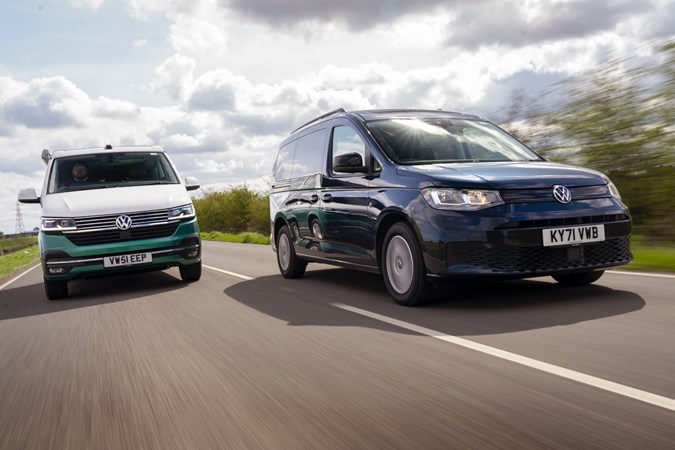
All manufacturer-backed campervans on sale
Volkswagen California
This is the original and, in our opinion, the best of these vehicles currently on sale. Born in 2005, the California is made by Volkswagen itself, in a dedicated factory in Hanover. Based on the Transporter van, it really is the Rolls-Royce of manufacturer campervans – nothing we’ve tested comes close to the same level of build quality and seamless integration.
The California has a classic side-kitchen layout with a rising roof, and there’s space for four to sleep with four belted seats for travel. It uses a very highly-specified base vehicle, with car-like interior equipment and powerful diesel engines, and all the interior functions can be controlled through a really intuitive panel just above the front seats. What’s more, in February 2022, VW released a modular system to making fitting it out even more straightforward.

It’s pricey to buy, though these vehicles do hold their value well, and in terms of equipment it misses out on an oven or grille and a toilet. But for luxurious mini-breaks we can’t think of much better.
We’ve reviewed the Volkswagen California in detail
Mercedes-Benz Marco Polo
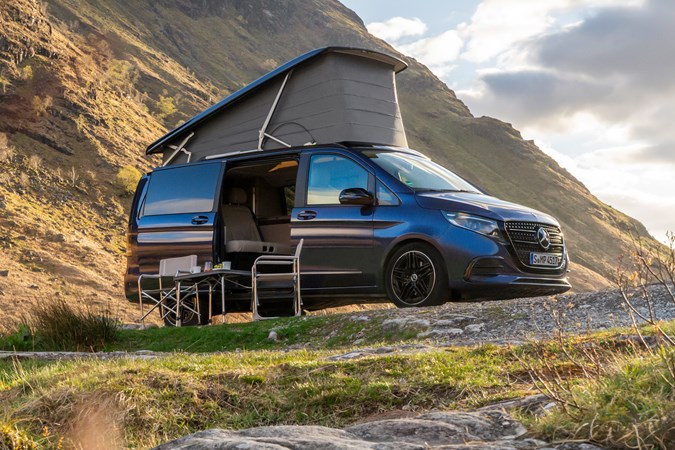
The California’s biggest competition comes from the Mercerdes-Benz Marco Polo. This is built for Mercedes by German camping giant Westfalia, and takes luxury to the next level with interior fittings that would look more at home in a high-end yacht.
It’s based on the Mercedes-Benz V-Class – technically a people-carrier rather than a van – which means it’s extremely plush in the cab and very comfortable to drive thanks to smooth, powerful engines.
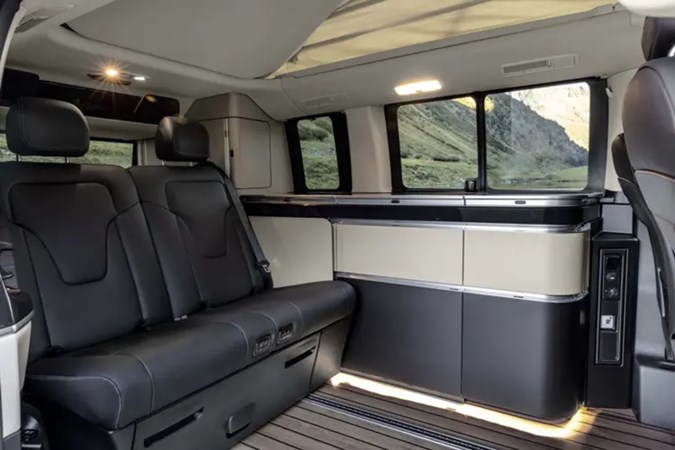
The Mercedes conversion feels just a bit less well-integrated than Volkswagen’s, and some aspects – such as the cab blinds or table leg – are rather fiddly to operate. Like the Volkswagen, it’s also very expensive. Nonethless, it’s a great second choice and perfect for couples who want ultimate luxury without worrying so much if everything’s hard-wearing.
We’ve reviewed the Mercedes-Benz Marco Polo in detail
Ford Transit Custom Nugget

The Transit Custom Nugget is also built by Westfalia, but is rather more utilitarian than the Marco Polo. That’s no bad thing, as it feels extremely solid inside. It’s also based on the Ford Transit Custom, a Parkers Award-winning van and the best vehicle in this class to drive.
Its unusual layout puts the kitchen at the back of the van, which could suit some buyers well – particularly families with young children who might want to entertain kids up front while someone cooks dinner separately at the rear.
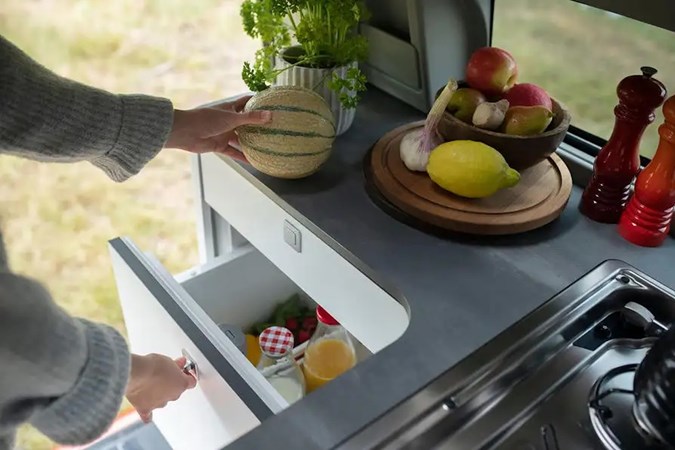
This same layout is rather awkward in some aspects, though, particularly the makeup of the downstairs bed. And the Nugget is a similar price to the Volkswagen California despite being less well-specified as standard.
All the details on the Ford Transit Custom Nugget
Vauxhall Vivaro Elite
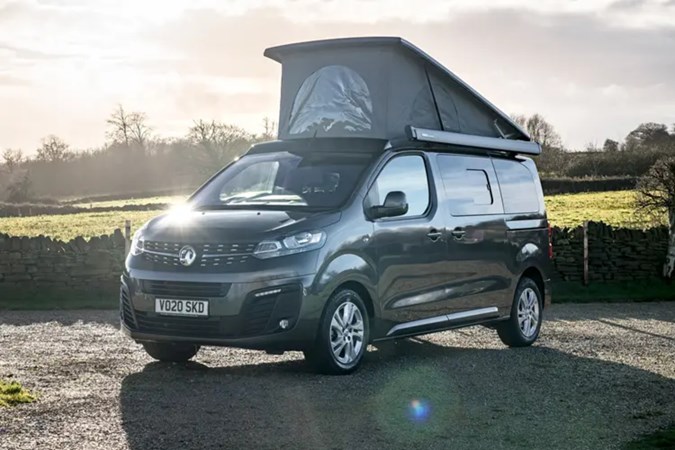
We’ve not yet tested the Vauxhall Vivaro Elite, which is the latest of these vans to be announced. Sold by Vauxhall and converted by Barnsley-based Wellhouse Leisure, it’s ideally suited to British motorcaravanners – its layout is handed correctly for right-hand drive markets, meaning the sliding door discharges passengers onto the pavement instead of the road.
Vauxhall also plans to build a version based on the Vivaro-e electric van, making for a unique and eco-friendly proposition.
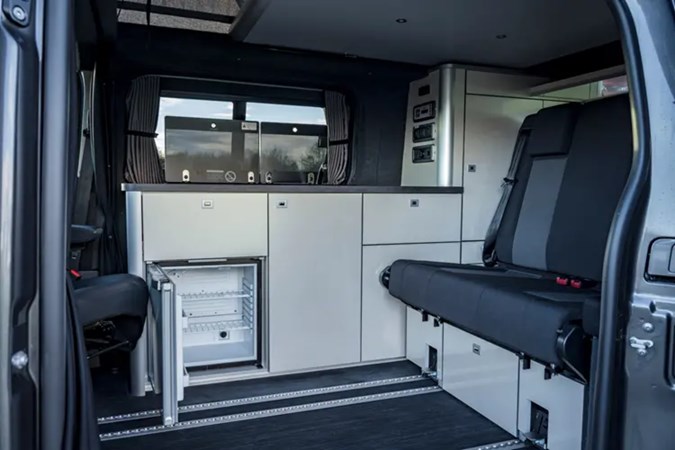
Wellhouse’s conversions are simple and solid and its Ford Transit conversions are well-regarded, so we’ve high hopes for the Vivaro Elite. Helping matters further is its bargain price – well below £50,000 when most of its competitors here cost close to £70,000.
All the details on the Vauxhall Vivaro Elite
Volkswagen Grand California
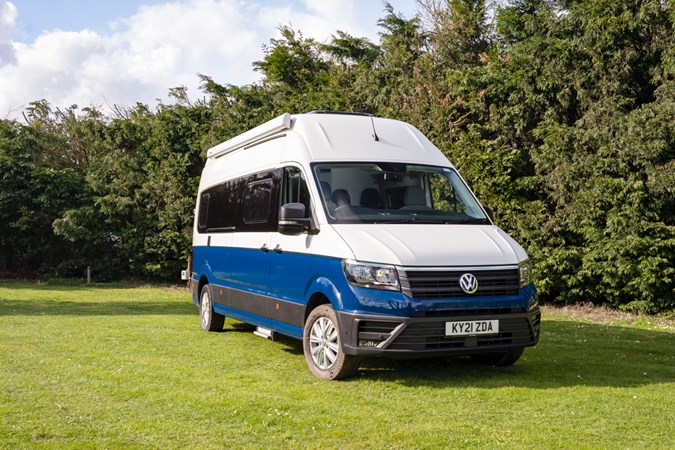
If you love the regular-sized California but want luxuries such as standing room throughout, a shower and toilet, and a permanent bed – the Grand California is for you. So far the only full-sized van conversion supported by a manufacturer, the Grand California is based on the brilliant Parkers Award-winning Crafter van, with conversion undertaken in-house by VW.
It’s available as a short-wheelbase, high-roof four-berth or a long-wheelbase, low-roof two-berth, but both feature the same sleek (if a bit sterile) interior design and layout. The four travel seats form a lounge up front, with the kitchen and all-in-one washroom positioned amidships.

With a price tag that starts above £70,000, you’ll need deep pockets, and the bigger body does mean parking and manoeuvring isn’t as easy as in a smaller van. But this is a vehicle ideally suited to longer getaways, and as with its smaller sibling the sense of quality is unbeatable.
We’ve reviewed the Volkswagen Grand California in detail
Volkswagen Caddy California
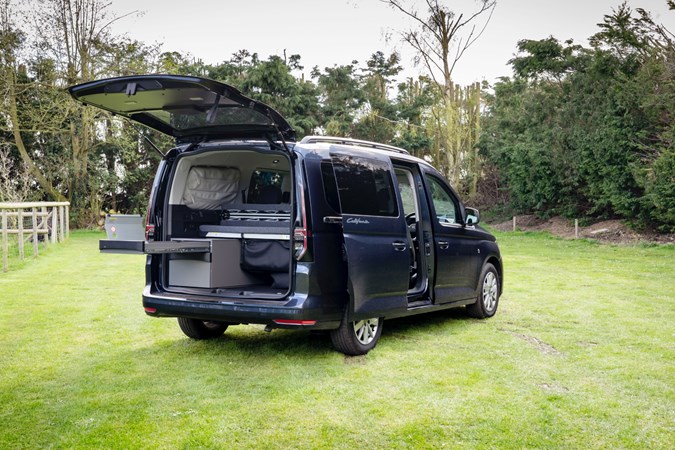
Another vehicle we’ve not yet driven – and we’re not entirely sure if we will, as Volkswagen hasn’t yet confirmed that it’s bringing the Caddy California to the UK. But we hope it does, as it’s a really intriguing take on the compact camper formula.
Based on the all-new Caddy Cargo, there’s a lot of Volkswagen Golf under the skin giving this a really car-like characteristic to drive. Its layout is perhaps better suited to a beach trip than a rainy Scottish getaway, though – the interior of the van is entirely taken over by the bed and the seats, with the kitchenette relegated to a pull-out drawer under the tailgate. A clip-on tent provides shelter for the chef.
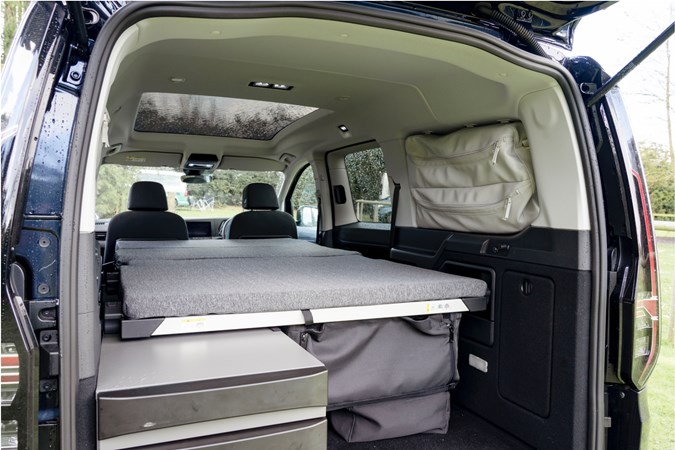
So, more of a mixture of a campervan and a tent – but nevertheless, it looks interesting, and if it’s as good as its larger siblings it’s a surefire success.
Everything we know so far about the Volkswagen Caddy California
Just so you know, we may receive a commission or other compensation from the links on this website - read why you should trust us.


